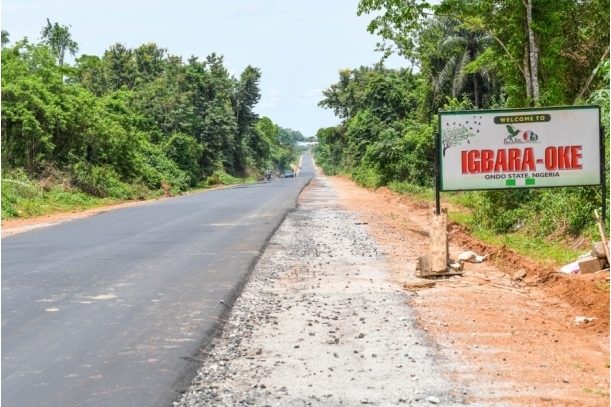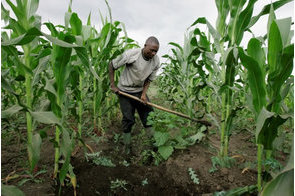Why good roads are essential to rural agriculture

Summary
Poor rural-urban connectivity is often why poor farmers are completely at the mercy of middlemen.
Last month, I visited a privately-owned farm estate in Abeokuta, Ogun State. The drive time from where I set out to the farm estate should have been around 20 minutes. Unfortunately, it took 45 minutes to get there, thanks to flooded roads and numerous potholes, which covered three-quarters of the trip. The condition of the road from the farm estate to other prominent areas on the outskirts of the city was no better.
I go through the same trouble, if not worse, trying to get to my farm in Ibadan, Oyo State. Undeniably, bad roads are common features in areas where farming activities take place, especially rural communities, in the country. It should go without saying that good roads in rural communities are vital to the growth of the agriculture sector and its contribution to the economies of developing countries, including Nigeria. This is because road transportation is the major means of moving people (including farm workers), farm inputs and implements to and from the farms.
The movement of farm produce from farm to urban areas and other locations is also mostly done by road. But badly rutted and muddy roads increase the cost of transporting agricultural materials and farm workers to farm as well as the movement of farm produce to market. High cost of transportation inevitably contributes to increasing food prices.
Commuting to farms during the dry season is often easier than during the wet season when the bad roads are flooded and muddy. But personally, I look forward to the rainy season like many other farmers because the rains provide the free water for crops to thrive. Animals and fish, too, need rain water. It would be wonderful for rural farmers to have rains and good roads and enjoy both at the same time.
According to the World Bank, 80 percent of the world’s poor who live in rural areas depend on farming as a source of livelihood. The Food and Agricultural Organisation of the United Nations (FAO), in a different report, revealed that 80 per cent of the world’s food is produced on family farms, which are predominately owned by smallholders in rural communities. Many of these farmers are, nevertheless, poor and food insecure. Among the reasons identified for their poverty and food insecurity is poor infrastructure, including roads and storage facilities, which restrict the farmers’ access to markets.
Good road network is a key factor in providing market linkages for rural farmers. Poor road infrastructure in rural communities does not only affect production and distribution of food. It also negatively impacts the development of rural areas.
For instance, the poor road conditions in rural communities make it difficult for farmers in those communities to have access to interventions and amenities such as financial assistance, training and education, clean and affordable drinking water, health services, electricity, schools, financial and other forms of support for the rural dwellers. As a result, rural farmers are further impoverished.
Fixing the appalling road conditions in rural areas will directly impact the productivity of farmers. Because of the ease of transporting farm materials and quicker access of experts and extension workers to farms, outputs could be greatly increased. For example, access to information and agricultural innovations can help farmers prevent or control disease outbreaks. They will also have quick access to improved crop varieties. Farmers who have access to high yielding crops that are resistant to pests and diseases tend to produce more and avoid losses.
Indeed, when farmers do not have to consider the trouble and cost of leaving their farms to get improved crop varieties and extension officers don’t have to consider the same to get to farmers, output will increase and more nutrient-rich crops will be grown. More farmers can access and grow varieties such as vitamin A-rich cassava, beans containing high-iron and zinc, among others for better nutrition. That way, the level of malnutrition in developing and low-income countries will be significantly reduced.
Farmers who can easily access large markets, due to better road infrastructure,are more likely to expand their farms and increase their outputs than those who have to struggle and spend more to move products out of their farms. Poor rural-urban connectivity is often why poor farmers are completely at the mercy of middlemen. These are traders who get products from the farms or markets in rural areas at very low rates and resell to city dwellers and processing industries at higher rates.
In that process, the middlemen make a lot of profit that should have been made by rural farmers. Apart from improving the income of farmers, investment in infrastructure, including good roads,in rural areas can help bridge the gap between rural dwellers – who are mostly farmers – and city dwellers. With good road networks industries, especially agriculture-based industries,could be encouraged to have branches or main plants in rural locations. More financial institutions and recreational centres would also be established, thereby, brightening up the rural environments.
Whilst boosting food security and financially improving the lives of rural farmers, adequate road infrastructure, as I have explained above, can minimize rural-urban migration. With the numerous improvements in the rural communities, including availability of social amenities, rural dwellers, and particularly young people,would be less interested in migrating to the cities. Curbing rural-urban migration – a key benefit of road infrastructure investment in rural areas –can also contribute in reducing pollution, crime and unemployment rates in urban areas.
For Nigeria and other countries across Sub-Saharan Africa (SSA) to produce and process more food for our continuously growing population, we must prioritise road and transportation infrastructure in rural and underserved communities. Whether we like it or not, the potential role of agriculture as the engine of growth in the sub-continent cannot be disputed. And rural agriculture is the mainstay of the agriculture sector in many countries across the region.
Therefore, if we must achieve zero hunger and end extreme poverty, which are key objectives of the Sustainable Development Goals (SDGs), we must find ways to boost agricultural activities in rural areas and improve the commercial capacity of smallholder farmers. The narrative of bad roads as a major impediment in farming communities in SSA must change.
Financial Nigeria Columnist, Mojisola Karigidi, is a Nigerian biochemist and the founder and product developer at Moepelorse Bio Resources. She is also a Global Innovation Through Science and Technology (GIST) awardee, and an Aspen New Voices fellow.
Related
-
IFAD projects improve food security among rural poor in Nigeria
Notable achievements were recorded with regard to access to finance, community capacity-building and job creation.
-
How agritech startups are helping smallholder farmers
Precision farming is being promoted by agritech startups the world over. But in Nigeria, many of the startups in this ...
-
Confab reviews Nigerian agriculture policy
The aim of the Abuja meeting is to develop a new policy to revamp the agriculture sector in Nigeria.










